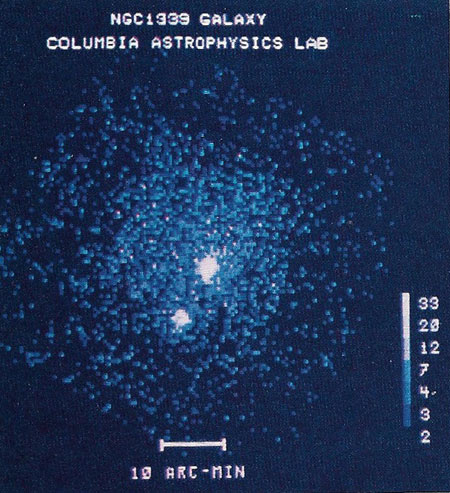X-ray astronomy satellites

Huge clouds of hot gas shine brightly around the galaxy NGC1399 when it is viewed in the short wavelengths of X-rays, recorded here by the X-ray telescope of the Einstein Observatory. Satellites can take instruments into space to observe the universe in ways which are impossible from the ground. X-rays from space cannot penetrate Earth's atmosphere to reach ground-based telescopes, and astronomers knew little about the exact shape and structure of X-ray emitting astronomical objects until the launch of the Einstein Observatory in November 1978. The gas shown here is at a temperature of 100 million degrees, and is invisible to ordinary light-gathering telescope.
| spacecraft | launch date |
| ALEXIS | Apr 25, 1993 |
| ANS | Aug 30, 1974 |
| ARGOS | Feb 23, 1999 |
| Ariel 5 | Oct 15, 1974 |
| Ariel 6 | Jun 2, 1979 |
| ASCA | Feb 20, 1993 |
| Astron | Mar 23, 1983 |
| BBXRT | Dec 2, 1990 |
| BeppoSAX | Apr 30, 1996 |
| Chandra X-ray Observatory | Jul 23, 1999 |
| Constellation-X | 2015? |
| Copernicus Observatory (OAO-3) | Aug 21, 1972 |
| DXS | Jan 13, 1993 |
| EXIST | 2007+ |
| Exosat | May 26,1983 |
| Gamma | Jul 11, 1990 |
| Ginga | Feb 5, 1987 |
| Granat | Dec 1, 1989 |
| Hakucho | Feb 21, 1979 |
| HEAO-1 | Aug 12, 1977 |
| HEAO-2 | Nov 12, 1978 |
| HEAO-3 | Sep 20, 1979 |
| HETE | Oct 9, 2000 |
| High Resolution X-ray Spectroscopy Mission | 2007+ |
| Hinotori | Feb 21, 1981 |
| Joule | |
| MAXIM | 2007+ |
| NuSTAR (Nuclear Spectroscopic Telescope Array) | Jun 13, 2012 |
| ROSAT | Jun 1, 1990 |
| RXTE | Dec 30, 1995 |
| SAS-3 | May 7, 1975 |
| Spectrum-X-Gamma | 2003 |
| Taiyo | Feb 24, 1975 |
| Tenma | Feb 20, 1983 |
| Uhuru (SAS-1) | Dec 12, 1970 |
| XEUS | |
| XMM-Newton | Dec 10, 1999 |


